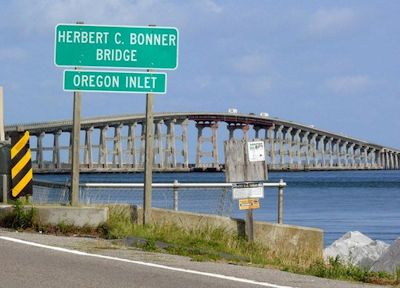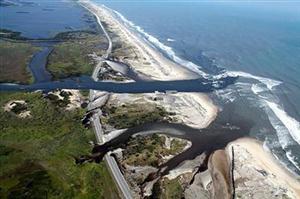 Planning and permitting for the replacement of the Herbert C. Bonner Bridge should continue despite the challenge of the CAMA permit. |
NAGS HEAD — Even as a federal lawsuit challenging a proposed replacement for the Herbert C. Bonner Bridge in Dare County is churning its way through a federal court, another legal action has suspended the state permit allowing construction of the bridge to begin.
The Southern Environmental Law Center, representing Defenders of Wildlife and the National Wildlife Refuge Association, last week filed a petition with the N.C. Coastal Resources Commission for a hearing to appeal the major CAMA permit issued on Sept. 20.
Supporter Spotlight
By law, the project has been stopped until the matter is resolved, but related tasks can continue.
“This does not impact any of the work that we’re doing now,” Greer Beaty, a spokeswoman for the state Department of Transportation, said Monday.
Beaty said that several permits from federal agencies are pending, and the $216 million project is on target to start construction in early 2013.
“We’re at a point in our work where we’re still finishing up design and testing and things of that sort,” she said. “This does not change our timetable at all. We’re going to keep working.”
The 2.5-mile Bonner Bridge, situated in the notoriously wild waters of Oregon Inlet, was opened in 1963 and is about 20 years overdue for replacement. DOT inspects and repairs it regularly and says it is safe to cross. As the only link to Hatteras Island, the span is crucial to the tourism-dependent economy on Hatteras and Ocracoke islands and to the more than 5,000 residents who live year-round on the islands.
Supporter Spotlight
 Bobby Outten |
 Julia Youngman |
The commission’s chairman, Robert Emory, must respond to the request by Oct. 23. If he decides that a hearing is not warranted — petitioners must prove that the permit decision violated a law or rule; that they are directly affected; and that their request is not frivolous — then the law center can petition for judicial review in state Superior Court in Dare or Wake counties.
If Emory agrees to grant the hearing, the law center must file a petition for a contested case hearing with the state Office of Administrative Hearings. The case would be heard by an administrative law judge, whose ruling is final but can be reviewed in state Superior Court.
It is not unusual to see such requests in controversial projects, said Michele Walker, CRC spokeswoman. “We were not surprised,” she said.
Considering the continued complexity and challenging nature of the project, Walker said that the commission has taken pains to ensure that regulatory requirements have been met.
“We were able to work with DOT and other agencies upfront in planning,” she said.
Bobby Outten, Dare County manager and attorney, said that he has been assured all along that DOT has done everything possible to comply with rules and regulations, especially in anticipation of a lawsuit being filed — as happened —-after the final step in the planning process was completed.
“We expect that the Southern Environmental Law Center will exhaust every avenue that they can,” Outten said, “to slow down or stop construction of that bridge.”
After more than 20 years of countless inter-agency meetings and heated public hearings, intermittent designing, planning and redesigning, not to mention behind-the-curtain political head-butting and arm-twisting, DOT finally awarded a $215.8 million contract in July 2011 to design-build team PCL Civil Constructors Inc. and HDR Engineering Inc. of the Carolinas. Completion is targeted for 2016, and demolition of the old bridge would begin the next year, with only a small portion left in place to use as a fishing pier.
The Coastal Area Management Act permit was issued last month after a 30-day public comment period and reviews by four federal and 10 state agencies.
Walker, with the CRC, said of the three public comments received, two were in favor, and one, from SELC, was opposed.
The petitioners said that the high erosion rate at hot spots on the island, coupled with growing risks from sea-level rise and climate change, make the proposed bridge a costly, wasteful and impractical option. Instead, they favor a previously planned 17.5-mile bridge that would bypass Pea Island National Wildlife Refuge, or alternately, using high-speed ferries to transport vehicles and people.
In July 2011, the law center and the other groups sued NCDOT and the Federal Highways Administration to stop the project.Progress on the project has not been affected. The matter is expected to be heard in the near future in federal court in New Bern.
In the recent request for a hearing, Julia Youngman, SELC’s senior attorney, contends, in part, that the permit should have been denied because the bridge project could harm water quality in Pamlico Sound and wildlife habitat in Pea Island National Wildlife Refuge, as well as historic and cultural resources. Youngman also said that the state exaggerated the cost of the rejected 17.5-mile bridge and didn’t bother to seriously study the use of fast, shallow-draft ferries.
 Hurricane Irene blew two inlets through the Pea Island National Wildlife Refuge south of the Bonner bridge, highlighting the vulnerability of N.C. 12. Photo: U.S. Fish and Wildlife Service. |
Youngman also contends that one of DOT’s more “egregious” violations of federal environmental laws is the way the project has been segmented. The CAMA permit only covers the first phase of the project — construction of a new bridge adjacent to the existing one. But, she argues, the effects of the maintenance of the road through Pea Island to Rodanthe, maintaining the rock groin on the south end of the bridge and the two bridges that will be constructed to repair damage in 2011 from Hurricane Irene should have been evaluated along with bridge construction.
In an e-mail, Youngman said that the group is “hoping to secure NCDOT’s compliance with federal and state laws, including CAMA,” but declined to say whether it wants the agency to change the project.
“Yet again,” she wrote,” NCDOT has asked a fellow agency to approve its plan by considering only a small part of the entire Bonner Bridge replacement project and turning a blind eye to the enormous problems with the remainder of the project that, if NCDOT acknowledged them, would likely preclude the permit from being issued.”
Many Outer Bankers objected to the long bridge because of safety concerns, but mainly because it cuts off access to unspoiled Pea Island, where surfing, birding, beachcombing and swimming are favorite activities for locals and visitors.
Hatteras resident Beth Midgett, chairwoman of the Citizens Action Committee to Replace the Bonner Bridge, said that the bottom line is that the nearly 50-year-old Bonner Bridge is running out of time. If the project is delayed much more, she said, it will become hazardous to cross. And if load restrictions are put in place because of structural deterioration, the daily and financial hardship, she said, would be significant.
“This will shortly be a public safety issue,” she said. “We are pouring money into this thing. In the off-season, it’s been in a fairly constant state of repair.”
Midgett mocked Youngman’s “pie-in-the-sky” ideas about using ferries to transport the nearly 3 million people who travel annually through Pea Island
“Perhaps even better would be jet packs from the mainland,” she said.
But for residents, Midgett said, the bridge is the only land route to the rest of the world. It represents their livelihoods, their lifestyles and their independence.
“This isn’t an expansion project,” she said. “This is our existence — and there’s a huge difference.”







